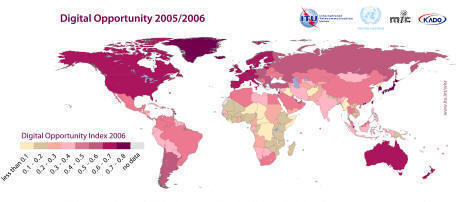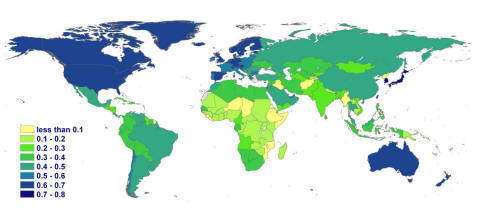The second edition of the World Information Society Report is out, bringing us a new calculation for the Digital Opportunity Index.
It’s a pity that the graphical representation of the Digital Opportunity Map has changed colors, as it makes it more difficult to compare among years. Nevertheless, here come both maps for 2006 and 2005 (remember that the report shows the DOI for the preceding year):
Major improvements — DOI increases above 20%, World Rank increases above 5 places (most of them are two digits increases) — are those of Antigua & Barbuda, Bangladesh, Barbados, Cambodia, Fiji, Guatemala, Lao P.D.R., Nicaragua, Palestine, Rwanda, St. Kitts & Nevis and Tanzania, reinforcing the trend of some Central America, Africa and Asia countries taking off and showing the path to other countries of the region with poor e-readiness results.
Getting worse — DOI decreases and loss of World Rank places —: Central African Republic, D.R. Congo, Madagascar, Turkmenistan and Zimbabwe, which as happened with the climbers, I think, sadly, does not surprise anyone.
Some other main conclusions are the huge strength of mobile telephony adoption in developing countries — in particular — and in the whole World — in general —, that makes coverage be almost universal and, thus, make the digital divide […] shrinking
. We’ve talked about this statement several times here, and luckily, this time the report warns about the danger that those infrastructures make broadband adoption more difficult than fixed lines, hence the availability and affordability of broadband remain a cause for concern
.
Actually, even if decreasing, inequality in digital development in the World (measured, for instance, through Internet usage) is still a major problem far to be solved and, if worst scenarios about broadband penetration come true, eager to get worse.
- World Information Society Report (main site)
 Full Report (13.4 Mb)
Full Report (13.4 Mb) Executive Summary (8.43 Kb)
Executive Summary (8.43 Kb) Map of Digital Opportunity Worldwide, 2005 (6.35 Mb)
Map of Digital Opportunity Worldwide, 2005 (6.35 Mb)- World Information Society Report 2006 and Digital Opportunity Index 2006
If you need to cite this article in a formal way (i.e. for bibliographical purposes) I dare suggest:
Peña-López, I. (2007) “World Information Society Report 2007 and Digital Opportunity Index 2007” In ICTlogy,
#44, May 2007. Barcelona: ICTlogy.
Retrieved month dd, yyyy from
https://ictlogy.net/review/?p=551
Previous post: Book: Internet Governance. Issues, Actors and Divides
Next post: W3C International Workshop on the Mobile Web in Developing Countries
2 Comments to “World Information Society Report 2007 and Digital Opportunity Index 2007” »
 RSS feed for comments on this post.
TrackBack URI
RSS feed for comments on this post.
TrackBack URI




I’d like to see the whole map with the same color.
Why do you think Central America is getting better every year?
Hi Pablo!
If you take the five centralamerican countries (Costa Rica, El Salvador, Guatemala, Honduras, Nicaragua) plus Panama and Belize, data are the following:
Even if the variation in the World Rank shows negative values, they are small and, I’d dare say, irrelevant. But the variations for the DOI value are all positive and, in three cases, above 20%. And, in the case of Guatemala and Nicaragua, accompanied by a sustained increase in the Human Development Index for i.e. the last six years.
So, I guess it looks like they’re doing pretty well :)